Agricultural Colony, Mettray, Indre-et-Loire, France
In July 1839, La Colonie Agricole, a reformatory for delinquent boys was opened at Mettray, a village in the French Department of Indre-et-Loire, about five miles to the north of Tours, and 150 miles to the south-west of Paris.
The institution was founded by Frédéric-Auguste Demetz, who had become interested in the large class of young offenders whom French law at that date were acquitted of the offence they had been charged with, on the ground of their having committed it without a sufficient knowledge of right and wrong. Such individuals could, however, be sentenced to 'detention in a house of correction' for their education and instruction in some honest means of livelihood. In 1839, Demetz set up a charity, La Société Paternelle, to improve the treatment of such offenders and visited a number of reformatory establishments in England, Germany, Holland and America. The Mettray colony, opened in collaboration with the Viscompt de Bretigneres de Courteilles, on whose estate it stood, was the result. It took boys aged from 7 to 15 at the time of their committal, with sentences never extending beyond the individual's twentieth birthday. Usually, after about three years at Mettray, situations were obtained for the boys with farmers of tradesmen in different towns and villages in the region. Those who did well were presented with an engraved ring on their twentieth birthday, while those who proved unsatisfactory could be transferred to a traditional house of correction for the remainder of their sentence.
The colony's most innovative feature was its organisation as a collection of 'families'. Each of these, comprising around forty boys plus a master and two assistant masters, resided in its own house. Each house had three storeys: the ground floor, which was used as a workshop; the first floor, which was used as a refectory and school room for all the boys of the family during the day, and at night as a dormitory for half of them; and the second floor, which was used as a dormitory for the remainder.
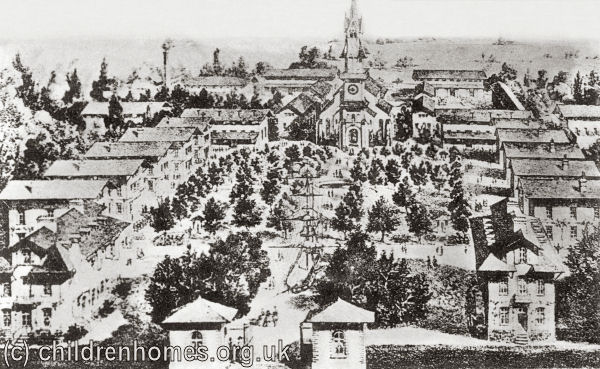
Mettray Agricultural Colony — bird's-eye view, early 1900s. © Peter Higginbotham
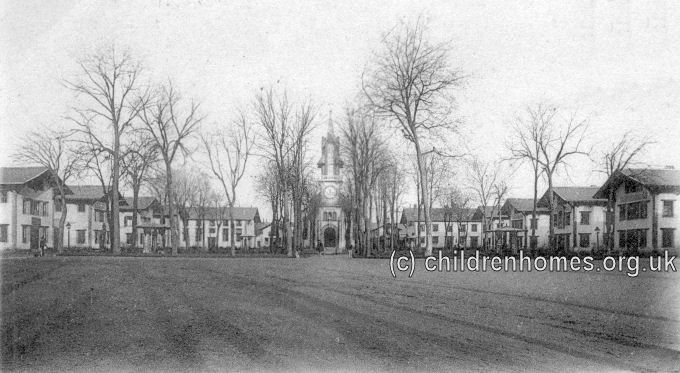
Mettray Agricultural Colony, early 1900s. © Peter Higginbotham
The boys of each family were responsible for the custody,cleaning, etc. of the lamps, cups, plates, etc. used by their companions. Within each family, two boys were elected each month to help with the discipline and order of the household. Known as frères aînés (elder brothers), those chose received some rewards and privileges. Prizes and rewards could also be given to the family of a boy demonstrating good conduct.
A church was subsequently erected at the centre of the site, with the boys attending divine worship twice on Sundays. On other days, prayers were read in each family in the morning and evening. The basement of the church contained punishment cells — this allowed the boys in confinement to share in the services without seeing or being seen by their companions. To keep the boys occupied, time on Sunday was also spent on instruction in the use of the fire engine, in military exercises, and in gymnastics. At various times, the boys were also taught to swim, to save persons from drowning, and to use the remedies to revive them, to climb a mast, to handle the sails and rigging of a ship, etc. In wet weather they were allowed the use of a lending library ,and to play chess and simple arithmetical games.
The daily routine began at 5 a.m., or 6 a.m. in winter, with bedtime all year round at 9 p.m. The day included an hour of school work, and about four hours occupied in meals, recreation, prayers, washing and dressing, etc. The rest of the day was devoted to labour, With their recreation mostly being gymnastic exercises, the boys were usually well disposed to go straight sleep at bedtime.
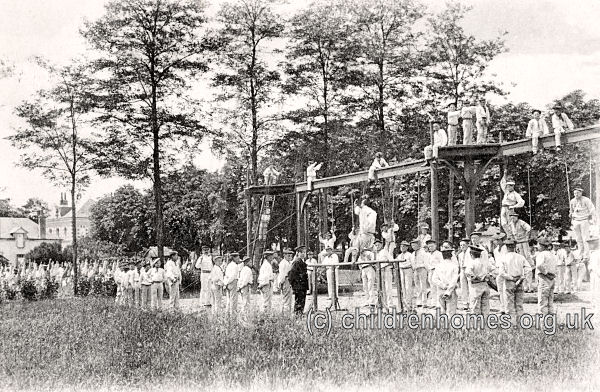
Mettray Agricultural Colony — gymnastics, early 1900s. © Peter Higginbotham
The accommodation, dress, food, etc. of all the inmates — including the officers — was of the plainest description. Fires were hardly ever allowed and the clothing was simple and utilitarian. The boys slept in hammocks, while the masters had simple beds. Each boy was provided with a separate box to keep his clothes in and had a clothes brush, a hair brush,and a comb given to him.
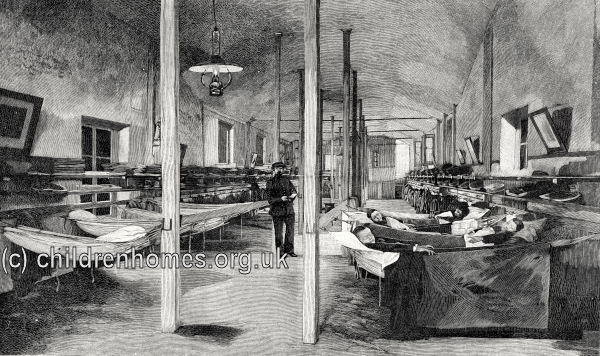
Mettray Agricultural Colony — dormitory, early 1900s. © Peter Higginbotham
The classroom instruction was based on the principle that the boys were taught only as much as an average agricultural or other labourer would acquire, namely to read, write, and do basic arithmetic. The more advanced boys were taught the elements of drawing and geography. All the boys were taught singing and some learned to play the wind instruments most commonly used in the Roman Catholic worship and in regimental bands. The labour tasks included making brushes and other basic household implements, digging the fields and breaking stones in the quarries.
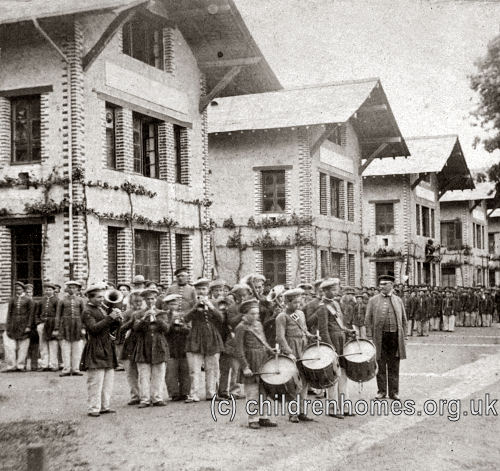
Mettray Agricultural Colony —parade, early 1900s. © Peter Higginbotham
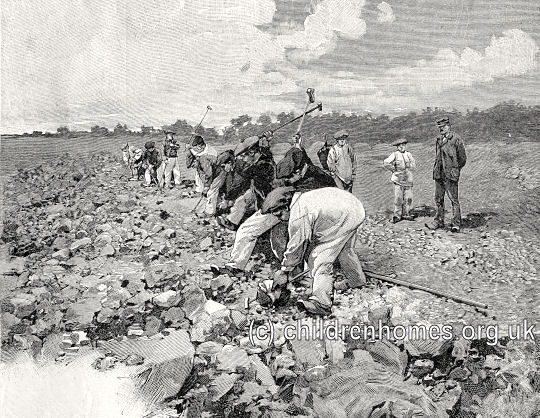
Mettray Agricultural Colony — stone-breaking, early 1900s. © Peter Higginbotham
With regard to discipline, the least fault was punished. The punishments were: making the boy stand apart from his companions, deprivation of meals and recreations, admonition in the 'parloir' of the Director (effectively a temporary arrest), imprisonment in a light or dark cell, with or without a dry bread and water diet, and, finally, expulsion — being sent back to the prison from where he had originally been received. Corporal punishment was utterly prohibited.
In its larger operation, the colony operated on a military system — moving to the sound of trumpets and marching in a military fashion.
Mettray became a highly influential model for the treatment of both young offenders and, more generally, the housing of children in residential care. During the 1840s and 1850s, it received many British visitors, such as Sydney Turner from the Philanthropic Society, Mary Carpenter, and Matthew Davenport Hill, who were interested in improving the treatment of juvenile offenders. The family group principle was widely adopted in the cottage homes developments established by a number of children's charities and poor relief authorities in England.
Mettray's most celebrated inmate was the writer Jean Genet who, from the age of 15, spent two and a half years there between 1926 and 1929. His novel Miracle of the Rose describe his experiences at Mettray The colony also features in philosopher Michel Foucault's history of modern imprisonment, Discipline and Punish.
Mettray ceased operation as a reformatory in 1937, by which time more than 17,000 boys had passed through its doors. Today, the site is home to the ITEP (Institut Thérapeutique Educatif et Pédagogique) Youth Village which provides educational and therapeutic services for young people.
Records
Note: many repositories impose a closure period of up to 100 years for records identifying individuals. Before travelling a long distance, always check that the records you want to consult will be available.
- None identfied at present — any information welcome.
Bibliography
- Carpenter, Mary Reformatory Schools, for the Children of the Perishing and Dangerous Classes, and for Juvenile Offenders (1851, General Books; various reprints available)
- Carlebach, Julius Caring for Children in Trouble (1970, Routledge & Kegan Paul)
- Higginbotham, Peter Children's Homes: A History of Institutional Care for Britain's Young (2017, Pen & Sword)
- Abel Smith, Doroth Crouchfield: A History of the Herts Training School 1857-1982 (2008, Able Publishing)
- Garnett, Emmeline Juvenile offenders in Victorian Lancashire: W J Garnnett and the Bleasdale Reformatory (2008, Regional Heritage Centre, Lancaster University)
- Hicks, J.D. The Yorkshire Catholic Reformatory, Market Weighton (1996, East Yorkshire Local History Society)
- Slocombe, Ivor Wiltshire Reformatory for Boys, Warminster, 1856-1924 (2005, Hobnob Press)
- Duckworth, J.S. The Hardwicke Reformatory School, Gloucestershire (in Transactions of the Bristol and Gloucestershire Archaeological Society, 1995, Vol. 113, 151-165)
Links
- Red Lodge Museum, Bristol — a former girls' reformatory.
- ITEP
Except where indicated, this page () © Peter Higginbotham. Contents may not be reproduced without permission.


